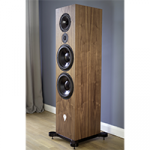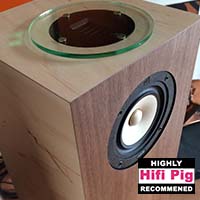PMC TWENTY5.23i LOUDSPEAKER REVIEW
Janine Elliot takes a listen to the PMC Twenty5.23i floorstandning Loudspeakers costing £4295.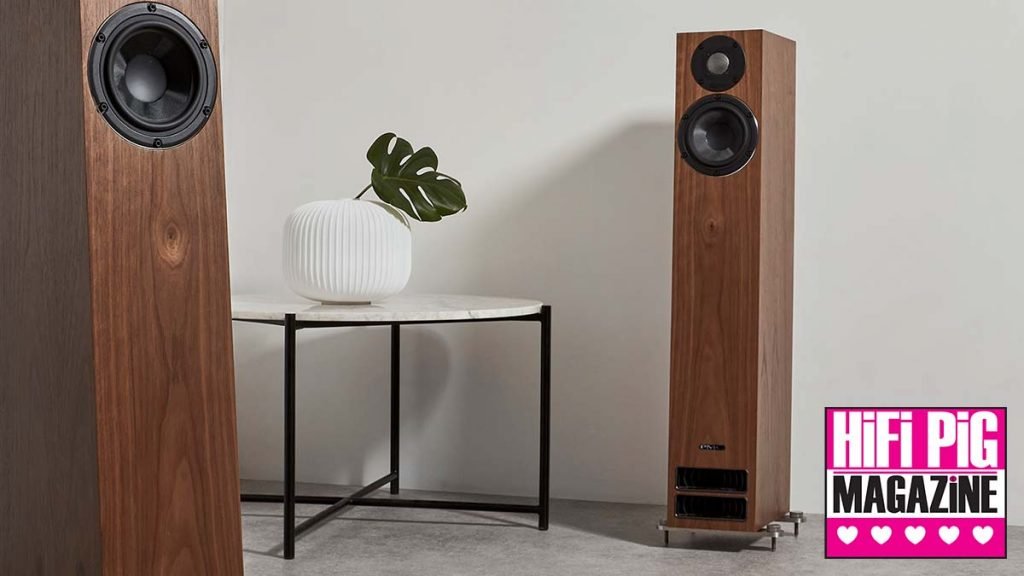
Back in 1990 I listened to a prototype PMC loudspeaker at BBC Broadcasting House where I was a Studio Manager and I recall that I actually wasn’t that enamored by it, I guess we were too used to LS3/5a’s and 5/8s. However, I have followed the company from when it started as a cottage industry to the behemoth it is now. Peter Thomas was at the time also at the BBC, working as Manager of Music Studios, and with co-founder Adrian Loader (an engineer at FWO Bauch) (both unsatisfied with loudspeakers in both studios and home) began their speaker revolution. The BBC was largely still using aged and tired LS5/8 speakers and so PMCs were a breath of fresh air, opening up detail in the sound that gave us a chance to fully hear the music and spoken words. Their professional speakers were soon to find themselves in major studios around the world as well as in many BBC studios and of course many homes.
The history of the company reads like a book, and their website is well worth a look. After four prototype models, the first BB5 (which stands for Big Box v5; although BBC Studio Managers thought it meant something ruder!) was sold to the BBC in 1990 prior to setting up the company the following year. 1991 saw the launch of the LB1 (Little Box..), their first domestic model, which incidentally also became quickly seen in BBC studios and other production facilities in the UK and abroad. In 1991 the first pair of BB5 XBD Actives, including PMC designed-and-built active electronics, were installed in BBC Maida Vale Studios, and later Athens Concert Hall, with the Metropolis studio also taking them in 1993. They started producing their own drivers from 1994, a 75mm midrange and 37mm tweeter. Their 1999 FB1 was designed as a home-audio floorstander, and set the company closer to being known by audiophiles. It wasn’t until 2011 that the Twenty series was created, aptly titled to celebrate 20 years of the company, and then in 2016 the Twenty5 series was created to celebrate…yes, you can work that one out. Both series had distinctive “raked back” laminated HDF enclosures to time align the tweeter.
It is the Twenty5.23i coming in at £4295 that I was sent for review, their smallest floorstander and one of six models in the series, which includes two standmount and two floorstanding two-way speakers, one flagship 3-way floorstander, and a centre speaker. There is also the Twenty5 sub to give greater bass to the standmount speakers or for a surround set-up.
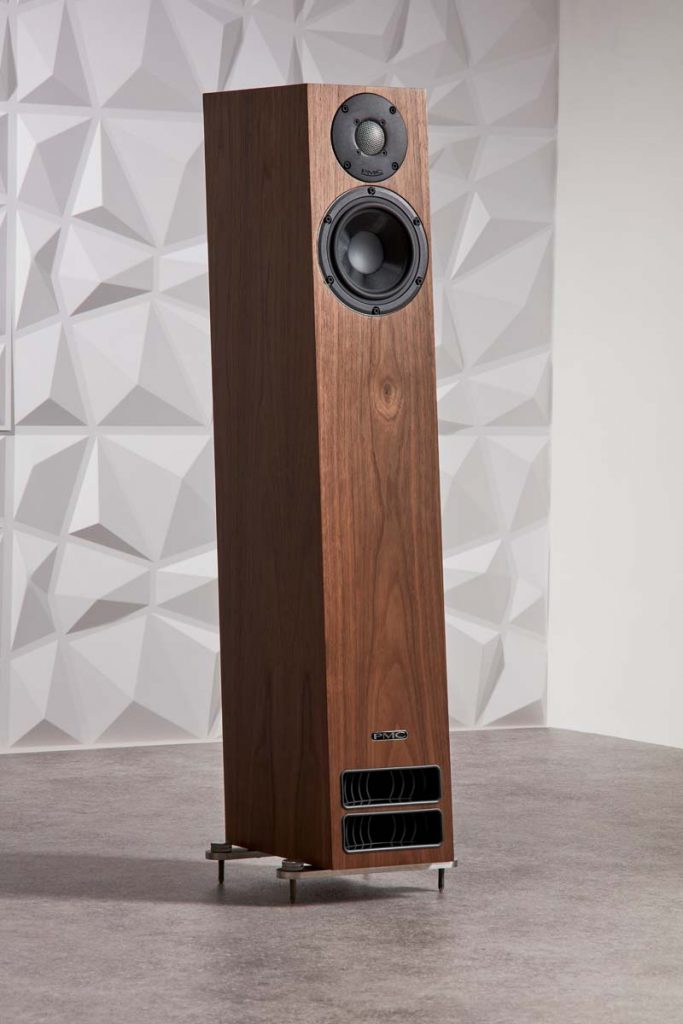
The PMC 2523i is sloped for time alignment of the tweeter.
LOCATION, LOCATION, LOCATION
The company has moved location several times during its history and now has two manufacturing areas in Sandy and Luton, with the head office in Biggleswade. It all started in Watford in 1992, and in 1995 they had offices in Welwyn Garden City. PMC has also set up demonstration studios in four locations around the world where you can audition studio monitors, and also hire them out for studio work such as Dolby Atmos. In 1993 they became importers for Canadian company Bryston and now are also agents for Martin Logan and AVM. Over the years PMC has produced many, many domestic and professional passive and active speakers and in 2018 this culminated in the excellent £55,000 Fact fenestria which was launched to great acclaim, and much of its technology has trickled down to the Twenty5 range – the tweeter, for example.
DESIGN STRATEGY
The 23i (where i stands for “improved”) appeared in 2020, with notable changes such as the 24dB crossover 100Hz lower at 1.7kHz. Having such a steep-order crossover is intentional. It not only allows greater power handling with no mid-frequency sounds getting to the bass driver, but it also means less distortion as the drivers are only used in their linear region. This creates a smoother sound and natural dispersion without phasing issues. As Keith Tonge, Creative Director informed me,
“We measure, grade, and record every component before they are hand soldered on the board so every pair is a perfect match (so a perfect central image). Our tolerances never drift and if a component has an issue, we can replace it with an identical value”.
The Twenty5.23i has 9 components in its crossover; two 2nd order electrical filters, an L-pad circuit for the tweeter, and an impedance correction circuit for the woofer. These 2nd order electrical filters are designed to work in tandem with the drivers’ own natural acoustic response to give an overall 4th order acoustic crossover response.
The 23i also has a new tweeter with a central 19mm dome and wider outer surround to radiate lower frequencies The grille in front of the tweeter is more than just a child and cat protector, rather it increases dispersion and improves the top end. The bass/mid is a 140mm unit assembled in their Luton branch, constructed from glass fibre which is both strong and well-controlled. The unit stands on metal plinths decoupled from the cabinet with damping rings that I found improved the soundstage, as opposed to when I used the speakers on my own supports. They use technology taken from the flagship Fact fenestria loudspeaker. When designing the Twenty5 they noticed resonance at around 470Hz due to feedback from the floor to the cabinet, and addressed it by using a clever mounting technique with a resonance-absorbing compound within the mount.
ATL AND F1
When you say the initials PMC you immediately think of transmission line, one of only a few companies using this technology rather than the more popular ported or sealed boxes. The 23i employs their excellent ATL (Advanced Transmission Line) technology; ported speakers generally allow all available frequencies to escape, but the ATL design dampens the top frequencies along its 2.4m (7.8ft) length and allows just the bass through. Bass frequencies arrive out of the vent in line with the next forward motion of the cone, effectively creating a second bass driver. The ATL also reduces displacement at resonant frequencies as the air movement becomes very stiff and stops the driver from moving, the internal foam absorbing all but the lowest frequencies. The vents for the ATL use F1 technology to eradicate turbulence, drag, and air noises, ensuring that the sound is a mirror of the bass driver. Conventional ports can slow down the music and make it unclear, but the LAMINAIR system employed here directs the sound out of the vent, a bit like the aerodynamic principles in an F1 car focusing the air movement. Indeed, Peter’s son Oliver, chiefly responsible for this technology, worked for Red Bull before coming to PMC, so he knows a lot about how air works under pressure.
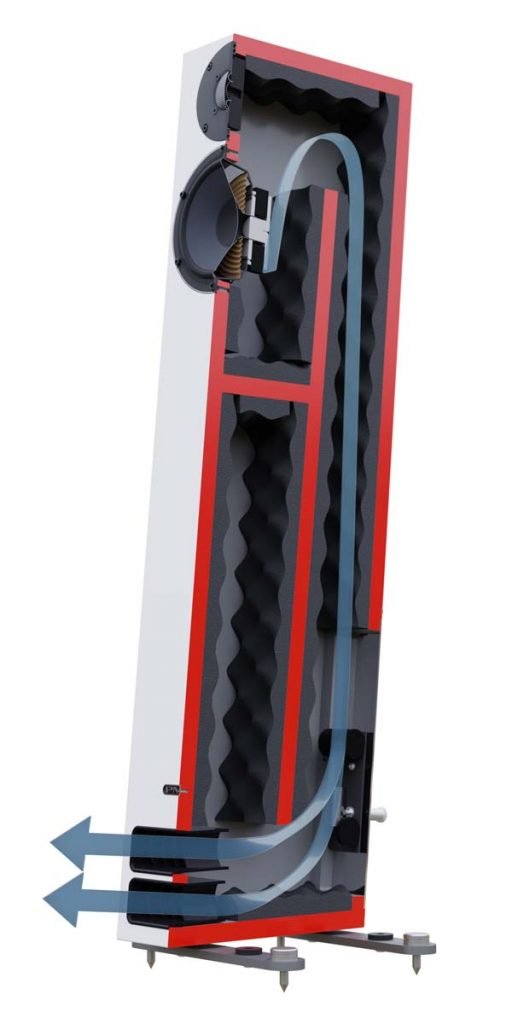
A cutaway of the PMC 2523ishowig the advanced transmission line
PMC 23i BUILD
These speakers are surprisingly thin at only 162mm (excluding the feet) meaning they fit into the room with very little footfall. The bass/mid is a small 140mm driver made by PMC and the 19mm Sonomex™ fabric soft dome tweeter is Ferrofluid cooled and with a 34mm surround and dispersion grille, a joint operation with SEAS. On first listening, you would think the bass unit is significantly bigger considering the bass extension to 28Hz. The unit comes in a choice of Walnut, Oak, White Silk, and Diamond Black. The review sample was walnut with an extremely well-braced 18mm HDF wall. The veneer is made from sustainable forests and hand selected. Unusually, it is veneered both inside and out, a technique derived from fine furniture and cabinet makers. As Toby Ridley, Principle Acoustics and R&D Engineer informed me;
“Because the wood of the veneer is a different material than the HDF of the cabinet panels, it will respond differently to changes in temperature and humidity than the HDF, expanding and contracting at a different rate. If the veneer is only applied to one side of the panel, this difference in the rate of expansion and contraction will lead to the panel warping slightly every time there is a change in temperature or humidity, which over time will weaken the cabinet’s joints. By veneering both sides of the panels, these expansion and contraction forces are balanced out, meaning that no warping occurs within the panels and the cabinet will remain strong and intact”.
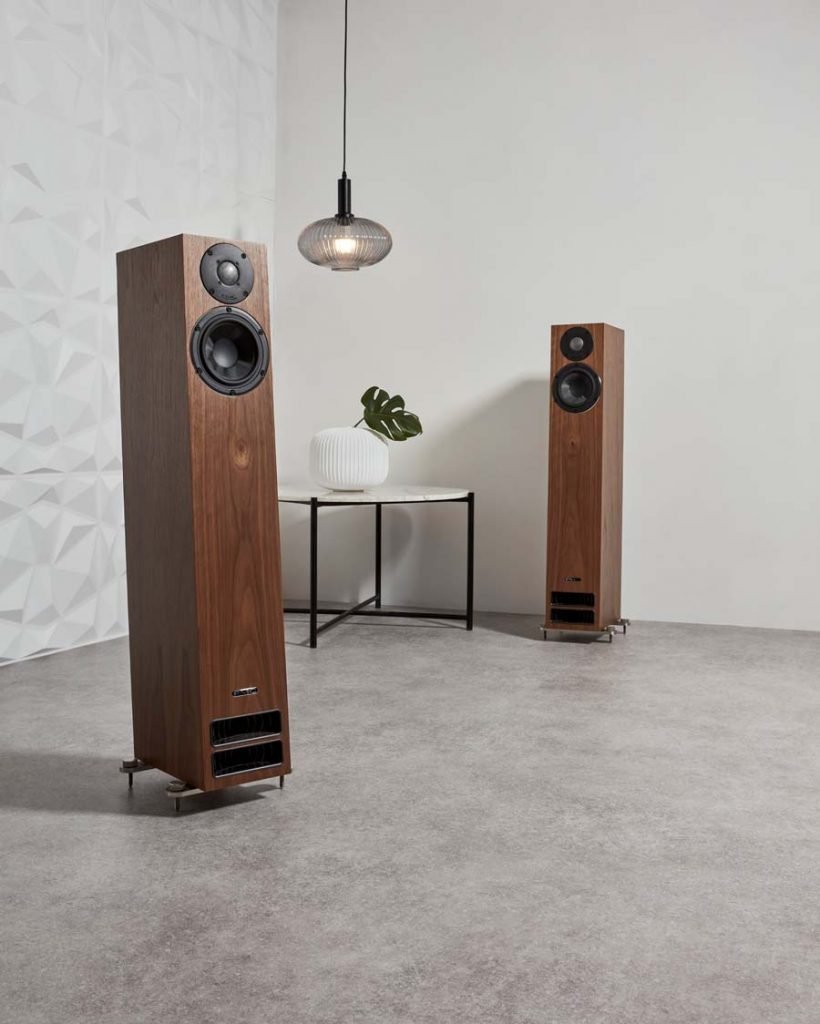
The PMC 2523i have a relatively compact size and are unfussy about placement.
SOUND OF THE PMC 23i LOUDSPEAKERS
On switch on it was apparent that there was great transparency and a wide soundstage that was extremely accurate and exhilarating. Kate Bush’s “Prelude” and “Birds” from ‘Aerial’ sent the creatures flying across the room confusing my cat. It was also noticed that I could move around the sitting area and still capture all the detail, unlike some speakers which expect you to be pinned down to a single sweet spot. Also, the positioning of the speakers wasn’t so critical; I could place them both close to a wall and further away and still get an accurate and musical performance. The bass extension was excellent and mids were warm and detailed. Top was precise and accurate. The piano was clear and realistic as were the vocals.
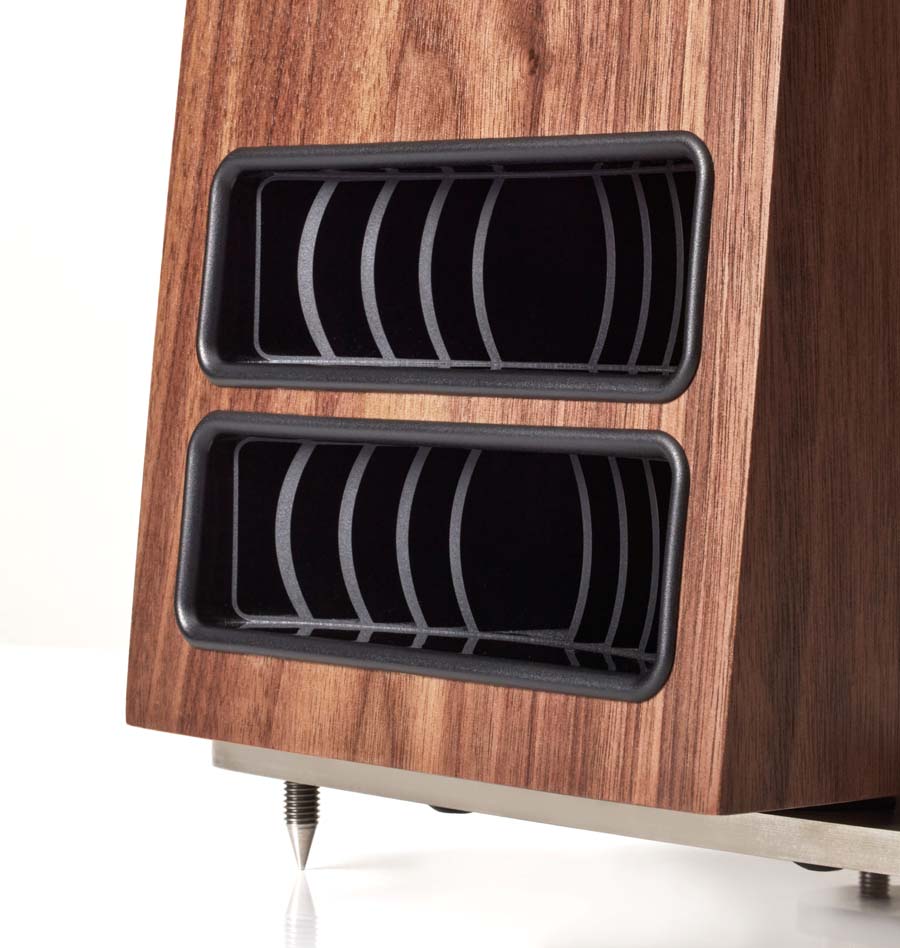
The vents for the ATL use F1 technology to eradicate turbulence, drag, and air noises.
Turning to Annie Lennox’s “Wonderful”, the vocal lines were realistic and full and the bass was very extended, and it filled the room. Having the crossover so low at 1.7kHz is so correct; it meant that vocals and strings would be accurate and quick. I have two pet hates; crossovers at 3kHz and on/off switches at the back of equipment! The chorus section was a lot more persuasive than I remember it being, showing the speed and clarity of this entry-level floorstander. There was a good soundstage that was behind and in front of the speaker. Having the speaker toed out so that the sound passed my ears around a foot away gave the best sound, particularly with regards to definition. Eva Cassidy’s “Fields of Gold” was the best I have heard it in a long time. Everything was natural and unfussed, as was it in Dire Strait’s live performance of “Private Investigation”. This had a good sense of atmosphere and again the bass was surprisingly precise and extended. The guitar burst at 07’10” only sounds a little more nasally than I would hear with bigger drivers.
Turning to classical and Vivaldi’s ‘Four Seasons’ the soundstage was given the opportunity to open up beautifully. The strings sang naturally and gave a performance that wouldn’t be out of place in a speaker costing twice the price. Similarly, in “The Battle” from the film ‘The Gladiator’ (Lyndhurst Orchestra), the performance was detailed and made me just want to keep listening; no surprise then that the Twenty5 series work so well in a 5.1 or bigger surround set-ups. This is a good track to check out soundstage as well as extremes of bass and dynamics, and the 23i performed excellently for the price. This sensitivity and space was also brilliantly captured again in Sacred Spirits “Legends” track. Only the very top frequency detail wasn’t quite so compelling as I’d have liked. Replacing my KT88 valve Synthesis with my solid-state Krell KAV250a enabled the top to be heard exactly in the way I would like. Don’t get me wrong, the top end is very good and is all there but with such a strong lower bass, once or twice it became somewhat stifled. Choose your amplification wisely.
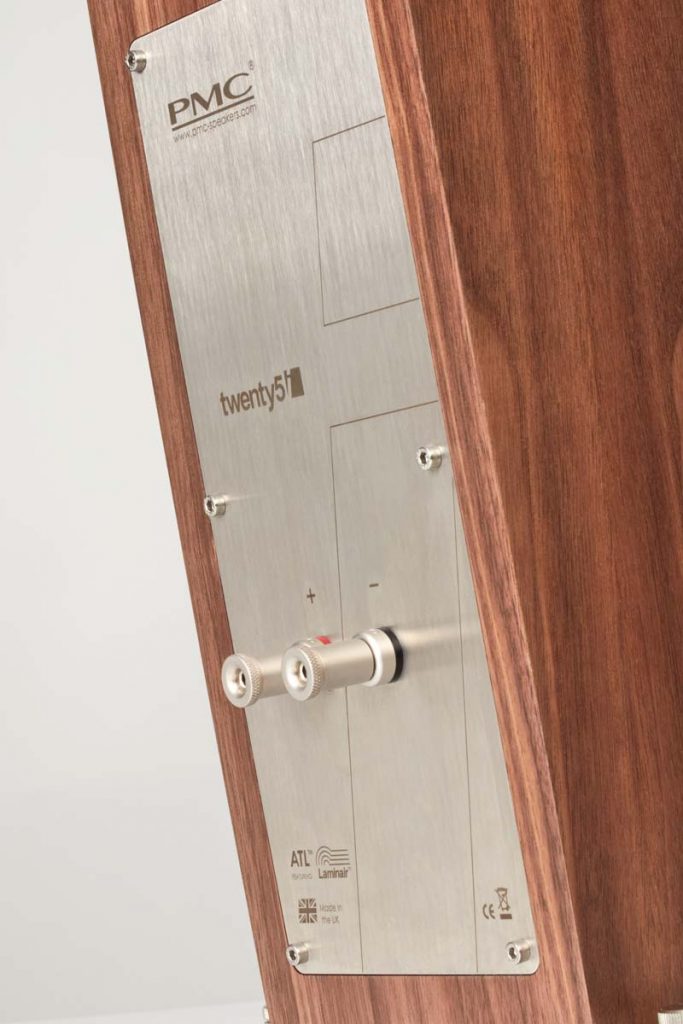
Quality parts are used throughout the construction.
These speakers worked just as well at low volume as they did at loud, with equal transparency and detail. That bass extension is excellent for the size and the 140mm driver does much to pretend it’s bigger.
I felt the best choice of music to conclude would be the Queen Studio Collection, produced on different coloured 180g pressings made by Optimal, and most importantly mastered on PMC MB2 XBDs. The original master tapes were played on Ampex machines and converted to 24bit/96kHz files before all the clever cleaning-up work began. ‘A Night at the Opera’ was a breath of fresh air; powerful kick drum and tight cymbals, clean piano lines, full vocals, and an extremely good soundstage. Perhaps I should have bitten the dust in 1990 and started investing in PMC speakers; the 23i is so much better than the first prototype I heard, but that of course is all part of development.
CONCLUSION
The Twenty5.23i has much to offer; a small footprint but a mammoth sound, even used with amps less than 150W. Working well with all types of music, the bass-end detail and extension are excellent, and the revealing sound especially in the mids makes this a speaker you really should audition.
But then, you’ll probably find that most of the music you play was already mixed and mastered on a PMC.
AT A GLANCE
Build Quality:
Excellently made, including the speaker terminals
Sound Quality:
Excellent lower bass response and a very well-balanced sound across all frequencies making them suitable for all types of music
A very revealing speaker
Value For Money:
Well made and excellent sound make them good value for money; the extra price over the original Twenty5.23 has been well put to use to create a far superior product
We Loved:
Bass extension
Mid-frequency warmth
Revealing and concise performance
Soundstage
We Didn’t Love So Much:
Wish there were more veneer finishes
Elevator Pitch Review: PMC have a great history of making speakers, with models appearing in most major studios, as well as in many households, so as someone who heard the very first prototypes back in 1990, it was right for me to take a listen to their most popular floorstander, the Twenty5.23i, and boy was I impressed.
Price: £4295

Janine Elliot
Review Kit: Pre-Audio GL-1102N/AT33sa (turntable/cartridge); Manley Steelhead (phono stage); Krell KPS20i (CD); Ferrograph Logic7 (reel to reel); Astell and Kern SE180/iFi xDSD (DAP/streamer) Synthesis Roma 98DC and Krell KAC250i (amplification); Esprit and Townshend cables, Townshend rack.
SPECIFICATIONS
Available Finishes: Walnut, Diamond Black, Oak, White Silk
Crossover Frequency: 1.7kHz
Dimensions: H 907mm (35.7”) x W 162mm (6.4”) (238mm incl. plinth bars) x D 330mm (13”) (+9mm grille)
Drive Units: LF PMC 5.5”/140mm long-throw g-weave™ cone with cast alloy chassis
HF PMC/SEAS®, 19mm twenty5i series, SONOMEX™ fabric soft dome, Ferrofluid cooled, with 34mm surround and dispersion grille
Effective ATL™ Length: 2.4m (7.8ft)
Frequency Response: 28Hz – 25kHz
Impedance: 8 Ohm
Input Connectors: One pair 4mm binding posts
Sensitivity: 86.5dB 1W 1m
Recommended Amp Power: 25 – 150W
Recommended Drive Unit Torque Settings: HF: 0.6Nm LF: 0.75Nm
Weight: 15kg (33 lbs ea.)

















































